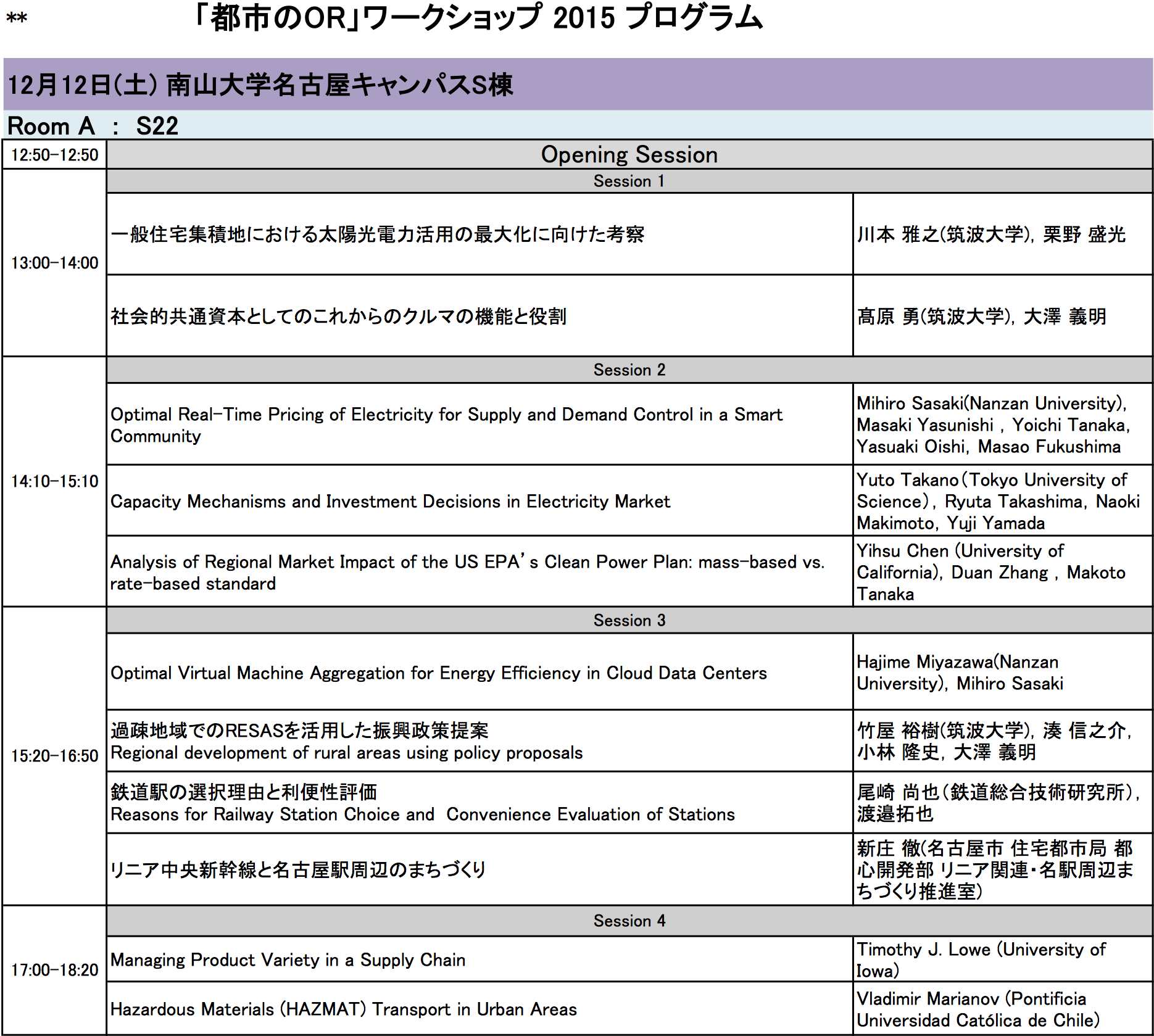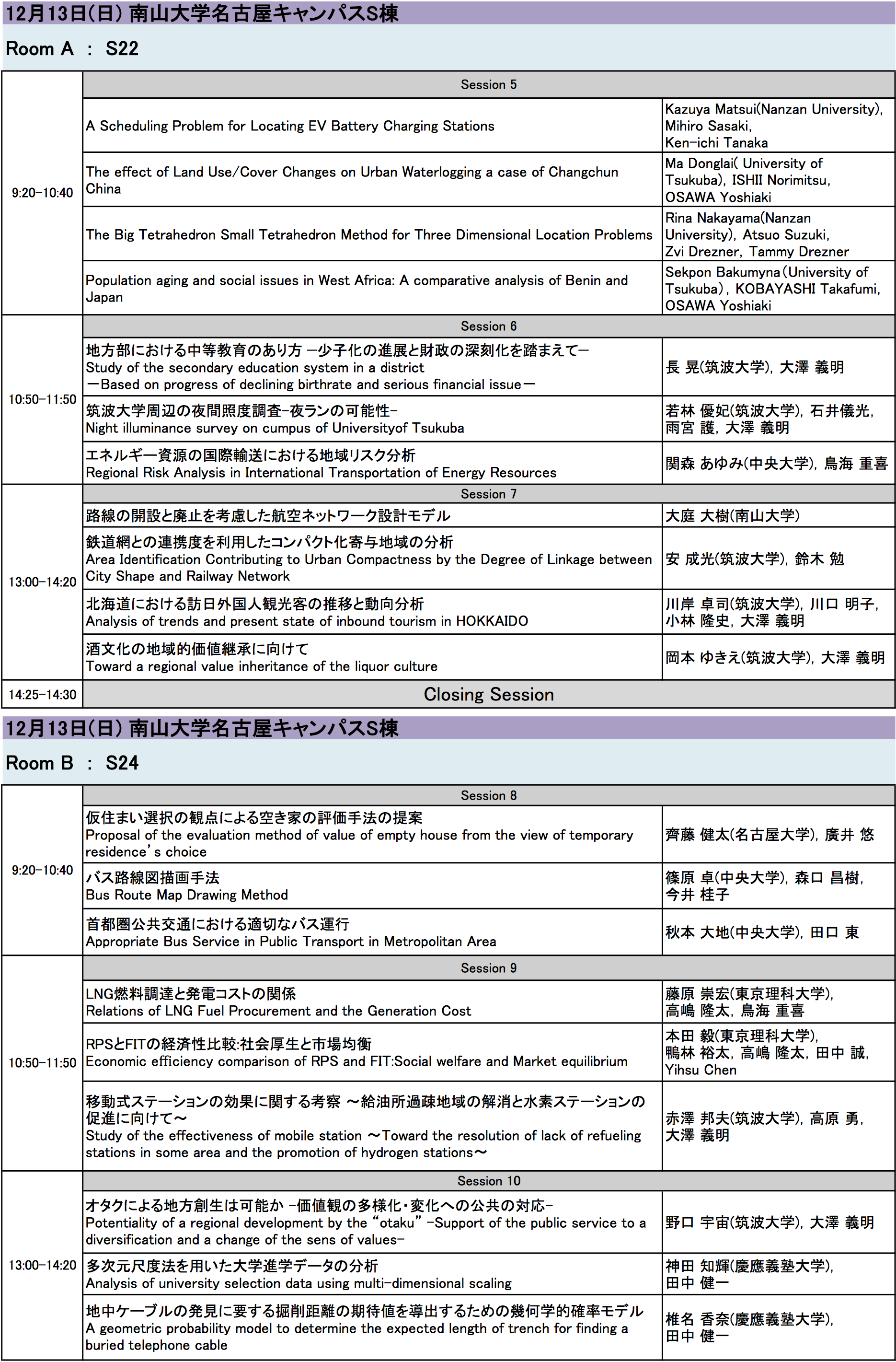スケジュール(最終版)(PDF版)
招待講演は,下記となります.その他の詳細は決まり次第,当ページにてお知らせいたします.
招待講演
- Prof. Timothy J. Lowe
- Managing Product Variety in a Supply Chain
- [click here to see the abstract]
Author: Timothy J. Lowe, Renato De Matta, Lifang Wu
Abstract: This paper investigates a vertically differentiated product line (VDP) design problem in both a centralized and decentralized supply chain setting with one manufacturer and one retailer. In the decentralized setting, we show that for our market model the manufacturer could opt to offer fewer products in comparison to the centralized system, and the resulting channel loss is at least one fourth of the total profit realizable with a centralized system. We also show the value of flexibility, information, and (design) lead time reduction in 3 market scenarios where the retailer may elect to not carry a product if the product does not meet a specified retailer target profit β. Our results reveal that if the manufacturer faces a long design lead time and designs only one product line, he may be better off not lowering wholesale prices to accommodate the retailer’s profit restriction. However, if the manufacturer develops multiple product lines and needs to decide which product line to offer the retailer, the size of the product line that will maximize his profit is nonincreasing in β. Optimization models and computational results are presented.
Abstract: This paper investigates a vertically differentiated product line (VDP) design problem in both a centralized and decentralized supply chain setting with one manufacturer and one retailer. In the decentralized setting, we show that for our market model the manufacturer could opt to offer fewer products in comparison to the centralized system, and the resulting channel loss is at least one fourth of the total profit realizable with a centralized system. We also show the value of flexibility, information, and (design) lead time reduction in 3 market scenarios where the retailer may elect to not carry a product if the product does not meet a specified retailer target profit β. Our results reveal that if the manufacturer faces a long design lead time and designs only one product line, he may be better off not lowering wholesale prices to accommodate the retailer’s profit restriction. However, if the manufacturer develops multiple product lines and needs to decide which product line to offer the retailer, the size of the product line that will maximize his profit is nonincreasing in β. Optimization models and computational results are presented.
- Prof. Vladimir Marianov
- Hazardous Materials (HAZMAT) Transport in Urban Areas
- [click here to see the abstract]
Author: Andrés Bronfman, Vladimir Marianov
Abstract: A model for route design is proposed in which the effects of HAZMAT transportation are an attribute of population centers (discrete points in a plane), rather than links of the route. Each center is surrounded by a circular hazard area. The use of a route segment within this area exposes the center. As an example of use, a model is proposed in which public perceptions are taken into account and measured as a level of perceived or real hazard, which depends on the exposure time and/or distance between the center and each point of the route.
Then, a risk averse model is proposed for HAZMAT transportation. The distance between the route and its closest vulnerable center (school, hospital, senior citizens’ residence), weighted by the center’s population, is maximized. The problem is formulated over a road network. We present an exact model, as well as an optimal polynomial time heuristic.
Next, we introduce the maxisum HAZMAT routing problem, which maximizes the sum of the population-weighted distances from the route to the set of vulnerable centers. Also, the maximin-maxisum HAZMAT routing problem. We propose IP formulations in which we manage to significantly reduce the required variables, so they require reasonable amounts of time for practical size instances.
All formulations and heuristics are presented and tested on a real case in the city of Santiago, Chile.
Abstract: A model for route design is proposed in which the effects of HAZMAT transportation are an attribute of population centers (discrete points in a plane), rather than links of the route. Each center is surrounded by a circular hazard area. The use of a route segment within this area exposes the center. As an example of use, a model is proposed in which public perceptions are taken into account and measured as a level of perceived or real hazard, which depends on the exposure time and/or distance between the center and each point of the route.
Then, a risk averse model is proposed for HAZMAT transportation. The distance between the route and its closest vulnerable center (school, hospital, senior citizens’ residence), weighted by the center’s population, is maximized. The problem is formulated over a road network. We present an exact model, as well as an optimal polynomial time heuristic.
Next, we introduce the maxisum HAZMAT routing problem, which maximizes the sum of the population-weighted distances from the route to the set of vulnerable centers. Also, the maximin-maxisum HAZMAT routing problem. We propose IP formulations in which we manage to significantly reduce the required variables, so they require reasonable amounts of time for practical size instances.
All formulations and heuristics are presented and tested on a real case in the city of Santiago, Chile.
12月12日(土)

12月13日(日)

